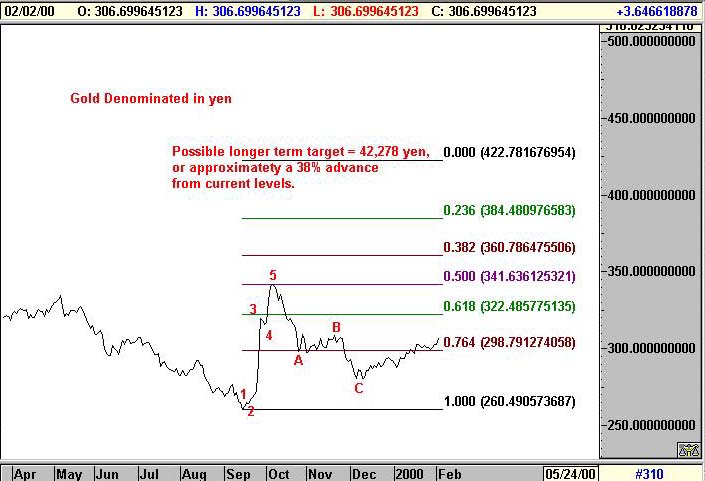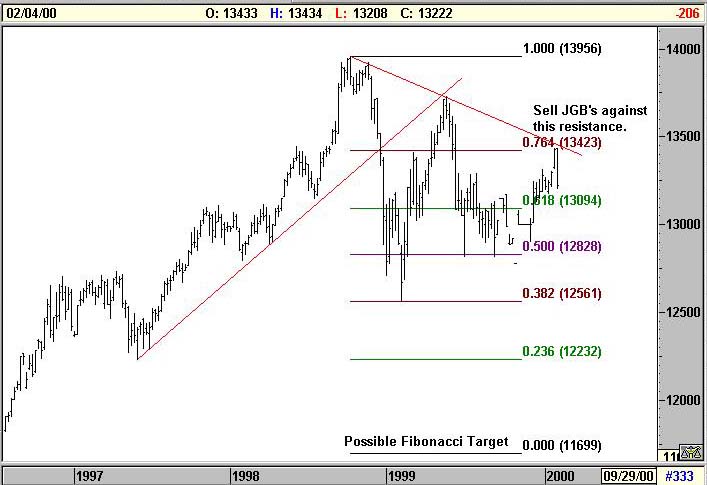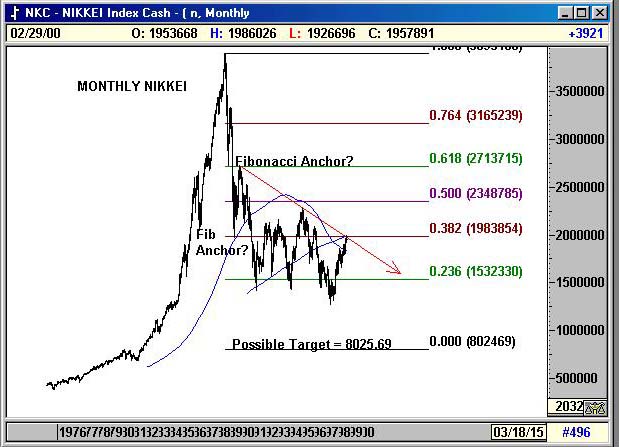

The Chart du Jour
Did you miss seeing the Chart du Jour updated yesterday? Remember, this portion of Sandspring.com is free, but we are also trying to make a living. Please subscribe to our in-depth analysis "Three Peaks and a Domed House." By doing so you will not only obtain a fascinating picture of how markets often end extended bull phases, but you will provide us with a vote of confidence that you value and appreciate the analysis that appears here. Click HERE FOR INFORMATION ON ORDERING.Blind Man's Bluff:
Behind the Curve Everywhere
These people are all fixated on the wrong thing. Greenspan is a noted gradualist, and as such, his actions Wednesday were as most people expected them. Greenspan may be slowly letting himself fall a bit behind the curve, but he is doing just enough to maintain his credibility and not so much as to be blamed for any untoward market consequences. This is not news, this is not drama. This is a gradualist economist trying his best to find a muddled path through the tight quarters of late cycle froth.
The real drama is not here, but abroad -- and specifically in Japan which in recent days has adopted some highly irregular procedures for funding itself. Just to recap their situation, and to get everything straight, let's lay out the 1997-2000 sequence of events over there:
Step one -- As marked in time by the collapse of Yamaichi Securities, Japan's banks and economy were previously so insolvent (bad bank debt approximating 40% of Japan's GDP) that the government decided that a massive infusion of public funds and public spending projects were necessary.
Step two -- As a result of this massive spending (which has yet to truly stem the negative tide of the Japanese economy) Japanese government borrowing has now reached epidemic proportions, soon to be the highest of all OECD nations.
Step three -- This debt funding situation has been particularly exacerbated by Japan's Big Bang whereby the Japanese Postal Savings system (previously the biggest buyers of JGBs on behalf of domestic savers) is now losing its investor base, has already become technically insolvent due to all of its recent redemptions, and still faces further massive redemptions on the horizon.
Step four -- Unable to rely upon Postal Savings anymore, the government decides instead to fund itself by borrowing money directly from -- you guessed it -- the previously insolvent banks at rates 50 basis points higher than they otherwise would have paid via the JGB market. The ostensible reason given is to "help make these banks become more profitable."
Now give me a break. If this is not a "shell game" of the biggest magnitude, what is? If this is not a government trying to avoid market realities while quietly resorting to desperate measures, what is? If this is not a sign of inflationary tendencies of government to create the illusion of prosperity where no prosperity truly exists, what is?
The answers to all these questions are obvious. Japan has basically now created a two-tier funding market with the attitude that if the Japanese government is going to have to pay higher rates anyway, then they better make sure that these rates are paid to their own institutions and not to the outside gaijin world. If their currency depreciates as a result, then so much the better to help jump start their economy. This may seem like a reasonable idea in ways, but it is a huge sign of weakness, and an important sign globally that government sponsored inflation is anything but dead. Japan continues to be in serious trouble, and their financial bureaucrats continue to pull every possible trick in the book to perpetuate the roll-over of their debt while they fail to let the system naturally esponge itself.
The key question -- and we do not think there will be much question about this longer term, but there may be in the short term -- is will the financial markets turn a blind eye and let the Japanese bureaucrats get away with this? Might the financial markets even like this?
It is certainly interesting to note that shortly after Japan announced their new borrowing procedures, U.S. T-Bonds received their first solid bid in some time as did the U.S. dollar against the yen. This was clearly not coincidental, but instead smart money pouring out of Japan afraid of the impact that these measures will hold longer term for both the yen and their JGB market. This makes the U.S. markets appear healthier in the short term than these markets would otherwise have been given purely domestic factors. It is not because we have suddenly done anything particularly great in the U.S., CNBC's ever-bubbly analysis notwithstanding, but simply because such a bad situation continues to exist over there in Japan. Nonetheless, the U.S. markets' sense of "success" and dare we use the term, "hubris," continues to expand.
Extrapolated a bit, one could imagine that by trying the umpeenth magical way to avoid paying the piper, the Japanese might even create a short-term nirvana in the U.S. markets as money pours out of the yen and into U.S. Treasuries. Or perhaps they could cause a final late cycle rally in U.S. equities with the gold sector stocks and other inflation hedges in the lead as so often happens in the last gasp of global equity strength. Certainly the gold chart pictured below denominated in yen terms looks bullishly poised.

Also, contrary to our longer term negative equity market prognostications, one daily close in the U.S. markets in the near term back above the key 1428 March S&P level, and the "Bimbo Bull Market" on this side of the Pacific would likely be off-to-the races once again, much to the consternation of any reasonable and rational person. And here is the ultimate twist: the Japanese MOF head may bemoan the U.S. equity market bubble, but by trying to maintain interest rates in Japan at articifically low levels, they actually send capital scurrying abroad and help to perpetuate it.
This is as artificial and as out-of-balance a global economic situation as we have ever seen. It cannot continue forever. The piper on both sides of the Pacific will eventually have to be paid, and when that day comes, capital invested at the current time in either the U.S. markets or the Japanese markets will likely be destroyed -- basically to repay the perpetually rolled-over debt that we are now trying to minimize in importance. At this extended stage, we do not think it is a matter of "if this will happen," but simply a matter of "when." And we continue to see the timing of such an dramatic event residing not here in the U.S., but over in Japan. Despite Japan's weakness, they still control the pursestrings of the world, and have ever so much control over our destiny.
We thus cannot stress enough the importance of watching JGBs. If JGBs begin to collapse, this will be the first sign that the financial markets are beginning a revolt against the cunning of the global central bankers, and are tiring of the current charade. The markets will be beginning to call a spade a spade instead of merrily dealing another hand of "blind-man's bluff." Once a bit of downside momentum is then achieved in Japanese asset prices -- both the Nikkei and JGBs -- then we would eventually reach the inflection point where the marginal yen of capital would stop heading abroad and start heading home to offset and shore up the domestic Japanese losses. The U.S. might win in the short term, but it would still suffer horribly in the end. Indeed, in the worst of boom-bust scenarios, a short term Japanese-inspired commodity price spike might force Greenspan to catch up in his tightening just when Japanese markets capitulate lower -- serving up an unfortunate double whammy to U.S. investors. Nowhere would you be hearing any more "soft landing" talk at that point.

Finally, and to get more specific in our prognostications, we note on the chart above that the JGB market failed at an important weekly downtrend line in Wednesday trading. We note as well that the Nikkei is just under the 19,838 level that marks its 200-month moving average. We have previously predicted that the Nikkei is highly likely to fail below this level.

These markets are anything but bullishly poised. Instead, they seem ripe to us for decline. If so, it will be a huge warning shot across the bow of all global capital markets that unforgiving times are ahead. Japanese capital fleeing abroad might propigate the U.S. party for a nano-second, but then count to ten and sell.
Am I wrong about this? Please post your comments in the Sandspring.com chatroom.
Thank you for visiting Sand Spring Advisors LLC, Inc. We hope to hear from you again soon. For more information on Sand Spring Advisors actual programs, services, or to request a copy of a Disclosure Document, please phone us at 973 829 1962, FAX your request to 973 829 1962, or e-mail us at
info@Sandspring.com| Corporate Office: 10 Jenks Road, Morristown, NJ 07960 Phone: 973 829 1962 Facsimile: 973 829 1962 |
Best Experienced with
The material located on this website is also the copyrighted work of Sand Spring Advisors LLC. No party may copy, distribute or prepare derivative works based on this material in any manner without the expressed permission of Sand Spring Advisors LLC
This page and all contents are Copyright © 1999 by Sand Spring Advisors, LLC, Morristown, NJ